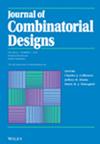求助PDF
{"title":"双序列群","authors":"Mohammad Javaheri","doi":"10.1002/jcd.21939","DOIUrl":null,"url":null,"abstract":"<p>Given a sequence <span></span><math>\n <semantics>\n <mrow>\n <mi>g</mi>\n \n <mo>:</mo>\n \n <msub>\n <mi>g</mi>\n \n <mn>0</mn>\n </msub>\n \n <mo>,</mo>\n \n <mi>…</mi>\n \n <mo>,</mo>\n \n <msub>\n <mi>g</mi>\n \n <mi>m</mi>\n </msub>\n </mrow>\n <annotation> ${\\bf{g}}:{g}_{0},{\\rm{\\ldots }},{g}_{m}$</annotation>\n </semantics></math> in a finite group <span></span><math>\n <semantics>\n <mrow>\n <mi>G</mi>\n </mrow>\n <annotation> $G$</annotation>\n </semantics></math> with <span></span><math>\n <semantics>\n <mrow>\n <msub>\n <mi>g</mi>\n \n <mn>0</mn>\n </msub>\n \n <mo>=</mo>\n \n <msub>\n <mn>1</mn>\n \n <mi>G</mi>\n </msub>\n </mrow>\n <annotation> ${g}_{0}={1}_{G}$</annotation>\n </semantics></math>, let <span></span><math>\n <semantics>\n <mrow>\n <mover>\n <mi>g</mi>\n \n <mo>¯</mo>\n </mover>\n \n <mo>:</mo>\n \n <msub>\n <mover>\n <mi>g</mi>\n \n <mo>¯</mo>\n </mover>\n \n <mn>0</mn>\n </msub>\n \n <mo>,</mo>\n \n <mi>…</mi>\n \n <mo>,</mo>\n \n <msub>\n <mover>\n <mi>g</mi>\n \n <mo>¯</mo>\n </mover>\n \n <mi>m</mi>\n </msub>\n </mrow>\n <annotation> $\\bar{{\\bf{g}}}:{\\bar{g}}_{0},{\\rm{\\ldots }},{\\bar{g}}_{m}$</annotation>\n </semantics></math> be the sequence of consecutive quotients of <span></span><math>\n <semantics>\n <mrow>\n <mi>g</mi>\n </mrow>\n <annotation> ${\\bf{g}}$</annotation>\n </semantics></math> defined by <span></span><math>\n <semantics>\n <mrow>\n <msub>\n <mover>\n <mi>g</mi>\n \n <mo>¯</mo>\n </mover>\n \n <mn>0</mn>\n </msub>\n \n <mo>=</mo>\n \n <msub>\n <mn>1</mn>\n \n <mi>G</mi>\n </msub>\n </mrow>\n <annotation> ${\\bar{g}}_{0}={1}_{G}$</annotation>\n </semantics></math> and <span></span><math>\n <semantics>\n <mrow>\n <msub>\n <mover>\n <mi>g</mi>\n \n <mo>¯</mo>\n </mover>\n \n <mi>i</mi>\n </msub>\n \n <mo>=</mo>\n \n <msubsup>\n <mi>g</mi>\n <mrow>\n <mi>i</mi>\n \n <mo>−</mo>\n \n <mn>1</mn>\n </mrow>\n <mrow>\n <mo>−</mo>\n \n <mn>1</mn>\n </mrow>\n </msubsup>\n \n <msub>\n <mi>g</mi>\n \n <mi>i</mi>\n </msub>\n </mrow>\n <annotation> ${\\bar{g}}_{i}={g}_{i-1}^{-1}{g}_{i}$</annotation>\n </semantics></math> for <span></span><math>\n <semantics>\n <mrow>\n <mn>1</mn>\n \n <mo>≤</mo>\n \n <mi>i</mi>\n \n <mo>≤</mo>\n \n <mi>m</mi>\n </mrow>\n <annotation> $1\\le i\\le m$</annotation>\n </semantics></math>. We say that <span></span><math>\n <semantics>\n <mrow>\n <mi>G</mi>\n </mrow>\n <annotation> $G$</annotation>\n </semantics></math> is doubly sequenceable if there exists a sequence <span></span><math>\n <semantics>\n <mrow>\n <mi>g</mi>\n </mrow>\n <annotation> ${\\bf{g}}$</annotation>\n </semantics></math> in <span></span><math>\n <semantics>\n <mrow>\n <mi>G</mi>\n </mrow>\n <annotation> $G$</annotation>\n </semantics></math> such that every element of <span></span><math>\n <semantics>\n <mrow>\n <mi>G</mi>\n </mrow>\n <annotation> $G$</annotation>\n </semantics></math> appears exactly twice in each of <span></span><math>\n <semantics>\n <mrow>\n <mi>g</mi>\n </mrow>\n <annotation> ${\\bf{g}}$</annotation>\n </semantics></math> and <span></span><math>\n <semantics>\n <mrow>\n <mover>\n <mi>g</mi>\n \n <mo>¯</mo>\n </mover>\n </mrow>\n <annotation> $\\bar{{\\bf{g}}}$</annotation>\n </semantics></math>. We show that if a group is abelian, odd, sequenceable, <i>R</i>-sequenceable, or terraceable, then it is doubly sequenceable. We also show that if <span></span><math>\n <semantics>\n <mrow>\n <mi>H</mi>\n </mrow>\n <annotation> $H$</annotation>\n </semantics></math> is an odd or sequenceable group and <span></span><math>\n <semantics>\n <mrow>\n <mi>K</mi>\n </mrow>\n <annotation> $K$</annotation>\n </semantics></math> is an abelian group, then <span></span><math>\n <semantics>\n <mrow>\n <mi>H</mi>\n \n <mo>×</mo>\n \n <mi>K</mi>\n </mrow>\n <annotation> $H\\times K$</annotation>\n </semantics></math> is doubly sequenceable.</p>","PeriodicalId":15389,"journal":{"name":"Journal of Combinatorial Designs","volume":"32 7","pages":"371-387"},"PeriodicalIF":0.5000,"publicationDate":"2024-03-30","publicationTypes":"Journal Article","fieldsOfStudy":null,"isOpenAccess":false,"openAccessPdf":"","citationCount":"0","resultStr":"{\"title\":\"Doubly sequenceable groups\",\"authors\":\"Mohammad Javaheri\",\"doi\":\"10.1002/jcd.21939\",\"DOIUrl\":null,\"url\":null,\"abstract\":\"<p>Given a sequence <span></span><math>\\n <semantics>\\n <mrow>\\n <mi>g</mi>\\n \\n <mo>:</mo>\\n \\n <msub>\\n <mi>g</mi>\\n \\n <mn>0</mn>\\n </msub>\\n \\n <mo>,</mo>\\n \\n <mi>…</mi>\\n \\n <mo>,</mo>\\n \\n <msub>\\n <mi>g</mi>\\n \\n <mi>m</mi>\\n </msub>\\n </mrow>\\n <annotation> ${\\\\bf{g}}:{g}_{0},{\\\\rm{\\\\ldots }},{g}_{m}$</annotation>\\n </semantics></math> in a finite group <span></span><math>\\n <semantics>\\n <mrow>\\n <mi>G</mi>\\n </mrow>\\n <annotation> $G$</annotation>\\n </semantics></math> with <span></span><math>\\n <semantics>\\n <mrow>\\n <msub>\\n <mi>g</mi>\\n \\n <mn>0</mn>\\n </msub>\\n \\n <mo>=</mo>\\n \\n <msub>\\n <mn>1</mn>\\n \\n <mi>G</mi>\\n </msub>\\n </mrow>\\n <annotation> ${g}_{0}={1}_{G}$</annotation>\\n </semantics></math>, let <span></span><math>\\n <semantics>\\n <mrow>\\n <mover>\\n <mi>g</mi>\\n \\n <mo>¯</mo>\\n </mover>\\n \\n <mo>:</mo>\\n \\n <msub>\\n <mover>\\n <mi>g</mi>\\n \\n <mo>¯</mo>\\n </mover>\\n \\n <mn>0</mn>\\n </msub>\\n \\n <mo>,</mo>\\n \\n <mi>…</mi>\\n \\n <mo>,</mo>\\n \\n <msub>\\n <mover>\\n <mi>g</mi>\\n \\n <mo>¯</mo>\\n </mover>\\n \\n <mi>m</mi>\\n </msub>\\n </mrow>\\n <annotation> $\\\\bar{{\\\\bf{g}}}:{\\\\bar{g}}_{0},{\\\\rm{\\\\ldots }},{\\\\bar{g}}_{m}$</annotation>\\n </semantics></math> be the sequence of consecutive quotients of <span></span><math>\\n <semantics>\\n <mrow>\\n <mi>g</mi>\\n </mrow>\\n <annotation> ${\\\\bf{g}}$</annotation>\\n </semantics></math> defined by <span></span><math>\\n <semantics>\\n <mrow>\\n <msub>\\n <mover>\\n <mi>g</mi>\\n \\n <mo>¯</mo>\\n </mover>\\n \\n <mn>0</mn>\\n </msub>\\n \\n <mo>=</mo>\\n \\n <msub>\\n <mn>1</mn>\\n \\n <mi>G</mi>\\n </msub>\\n </mrow>\\n <annotation> ${\\\\bar{g}}_{0}={1}_{G}$</annotation>\\n </semantics></math> and <span></span><math>\\n <semantics>\\n <mrow>\\n <msub>\\n <mover>\\n <mi>g</mi>\\n \\n <mo>¯</mo>\\n </mover>\\n \\n <mi>i</mi>\\n </msub>\\n \\n <mo>=</mo>\\n \\n <msubsup>\\n <mi>g</mi>\\n <mrow>\\n <mi>i</mi>\\n \\n <mo>−</mo>\\n \\n <mn>1</mn>\\n </mrow>\\n <mrow>\\n <mo>−</mo>\\n \\n <mn>1</mn>\\n </mrow>\\n </msubsup>\\n \\n <msub>\\n <mi>g</mi>\\n \\n <mi>i</mi>\\n </msub>\\n </mrow>\\n <annotation> ${\\\\bar{g}}_{i}={g}_{i-1}^{-1}{g}_{i}$</annotation>\\n </semantics></math> for <span></span><math>\\n <semantics>\\n <mrow>\\n <mn>1</mn>\\n \\n <mo>≤</mo>\\n \\n <mi>i</mi>\\n \\n <mo>≤</mo>\\n \\n <mi>m</mi>\\n </mrow>\\n <annotation> $1\\\\le i\\\\le m$</annotation>\\n </semantics></math>. We say that <span></span><math>\\n <semantics>\\n <mrow>\\n <mi>G</mi>\\n </mrow>\\n <annotation> $G$</annotation>\\n </semantics></math> is doubly sequenceable if there exists a sequence <span></span><math>\\n <semantics>\\n <mrow>\\n <mi>g</mi>\\n </mrow>\\n <annotation> ${\\\\bf{g}}$</annotation>\\n </semantics></math> in <span></span><math>\\n <semantics>\\n <mrow>\\n <mi>G</mi>\\n </mrow>\\n <annotation> $G$</annotation>\\n </semantics></math> such that every element of <span></span><math>\\n <semantics>\\n <mrow>\\n <mi>G</mi>\\n </mrow>\\n <annotation> $G$</annotation>\\n </semantics></math> appears exactly twice in each of <span></span><math>\\n <semantics>\\n <mrow>\\n <mi>g</mi>\\n </mrow>\\n <annotation> ${\\\\bf{g}}$</annotation>\\n </semantics></math> and <span></span><math>\\n <semantics>\\n <mrow>\\n <mover>\\n <mi>g</mi>\\n \\n <mo>¯</mo>\\n </mover>\\n </mrow>\\n <annotation> $\\\\bar{{\\\\bf{g}}}$</annotation>\\n </semantics></math>. We show that if a group is abelian, odd, sequenceable, <i>R</i>-sequenceable, or terraceable, then it is doubly sequenceable. We also show that if <span></span><math>\\n <semantics>\\n <mrow>\\n <mi>H</mi>\\n </mrow>\\n <annotation> $H$</annotation>\\n </semantics></math> is an odd or sequenceable group and <span></span><math>\\n <semantics>\\n <mrow>\\n <mi>K</mi>\\n </mrow>\\n <annotation> $K$</annotation>\\n </semantics></math> is an abelian group, then <span></span><math>\\n <semantics>\\n <mrow>\\n <mi>H</mi>\\n \\n <mo>×</mo>\\n \\n <mi>K</mi>\\n </mrow>\\n <annotation> $H\\\\times K$</annotation>\\n </semantics></math> is doubly sequenceable.</p>\",\"PeriodicalId\":15389,\"journal\":{\"name\":\"Journal of Combinatorial Designs\",\"volume\":\"32 7\",\"pages\":\"371-387\"},\"PeriodicalIF\":0.5000,\"publicationDate\":\"2024-03-30\",\"publicationTypes\":\"Journal Article\",\"fieldsOfStudy\":null,\"isOpenAccess\":false,\"openAccessPdf\":\"\",\"citationCount\":\"0\",\"resultStr\":null,\"platform\":\"Semanticscholar\",\"paperid\":null,\"PeriodicalName\":\"Journal of Combinatorial Designs\",\"FirstCategoryId\":\"100\",\"ListUrlMain\":\"https://onlinelibrary.wiley.com/doi/10.1002/jcd.21939\",\"RegionNum\":4,\"RegionCategory\":\"数学\",\"ArticlePicture\":[],\"TitleCN\":null,\"AbstractTextCN\":null,\"PMCID\":null,\"EPubDate\":\"\",\"PubModel\":\"\",\"JCR\":\"Q3\",\"JCRName\":\"MATHEMATICS\",\"Score\":null,\"Total\":0}","platform":"Semanticscholar","paperid":null,"PeriodicalName":"Journal of Combinatorial Designs","FirstCategoryId":"100","ListUrlMain":"https://onlinelibrary.wiley.com/doi/10.1002/jcd.21939","RegionNum":4,"RegionCategory":"数学","ArticlePicture":[],"TitleCN":null,"AbstractTextCN":null,"PMCID":null,"EPubDate":"","PubModel":"","JCR":"Q3","JCRName":"MATHEMATICS","Score":null,"Total":0}
引用次数: 0
引用
批量引用

 求助内容:
求助内容: 应助结果提醒方式:
应助结果提醒方式:


